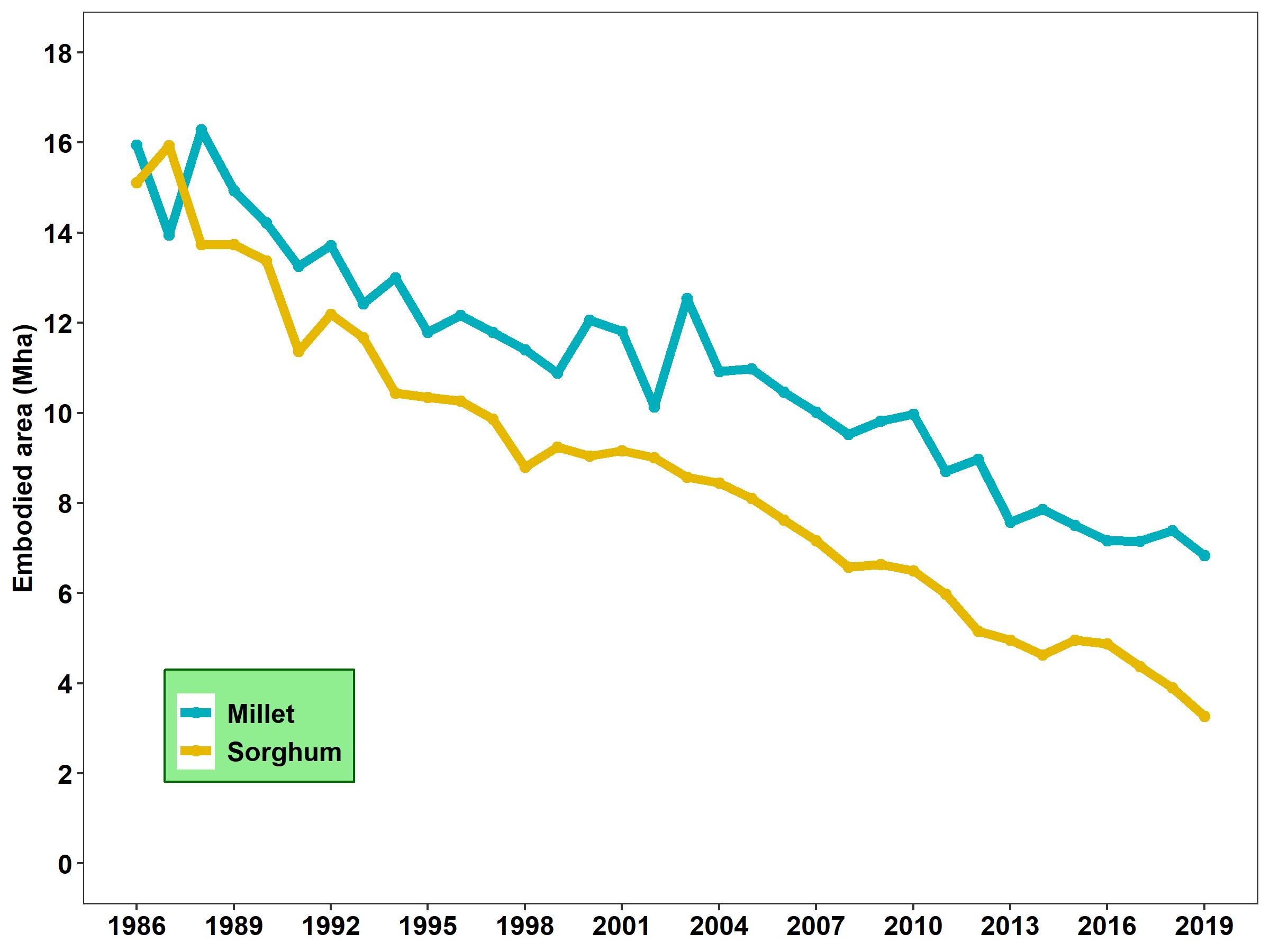In the first post of the e-Symposium on ‘Carrying forward the promise of International Year of Millets’, Manan Bhan introduces the concept of ‘embodied land area’, which accounts for land use at the point of consumption and places the burden of negative impacts on consumers rather than producers. He notes the decline in land area under use for the production of millets and sorghum, and the potential to expand millet cultivation, trade and consumption in a sustainable manner to benefit both producers and consumers.
India has a long history of cultivating and consuming millets. Millet cultivation remains a part of the cultural heritage of many regions, particularly in the semi-arid and sub-humid parts of the country. Ever since the onset of the Green Revolution and the introduction of high-yielding varieties of rice and wheat across the country, millet cultivation has undergone a steady decline. Despite this, India remains one of the biggest producers and consumers of sorghum (jowar) and several other millet varieties like pearl millet (bajra) and finger millet (ragi). Its share in the global millet trade, however, remains relatively small.
An opportunity for a global revival of millet cultivation has been presented by the United Nations General Assembly declaring the year 2023 as the International Year of Millets (IYM 2023) with the Food and Agriculture Organization leading the efforts in celebrating it. Increasing awareness about the desirable properties of millet varieties, both from a climate resilience and a nutritional perspective have been at the core of these efforts, and India remains at the forefront of this resurgence. Several new initiatives, including enhanced government support for the Indian Institute of Millets Research as well as the initiation of state-level millet missions (for example, the Odisha Millet Mission) have been announced to increase the production and consumption of millet varieties across the country.
In this article, I review the statistics on millets consumption in the country over the last three decades (that is, from 1986-2019) through the metric of ‘embodied area’. I distinguish millets for domestic consumption and those earmarked for exports to other countries to describe how millet production has changed in India over this time.
Using consumption-based accounting
The concept of ‘embodied’ area1 accounts for the area required to service the consumption of a given agricultural commodity in a given territory. For a given territory and commodity (say, India and millets), embodied area describes the area under millet production in India and imports into India for domestic consumption. This metric provides a consumption-based account, since it uses the quantities produced within a territory to trace the quantities consumed within the same or originating from a different territory. Since each territory records its production and trade statistics of given agricultural commodities, it is possible to estimate the corresponding consumption-based statistics.
In this way, a consumption-based accounting approach accounts for land use at the point of consumption. This means that it is the end consumer (either an individual or a country), instead of the producer of the given agricultural commodity – in this case, millets – that is ‘embodying’ the land used to produce that commodity.
This provides an alternative perspective on any country’s share of land used to produce an agricultural commodity. These metrics are then described in terms of primary equivalents (for example, trade and consumption of flour and bran is converted to its source produce, which is millets, and then represented as millets trade). Estimates are also corrected for re-exports (for example, India exporting to Germany which then exports to Austria will be shown as India-Austria trade), double cropping (production over multiple seasons on the same land, a common practice in India) and losses in the product value chain.
There is an increasing recognition of the negative socio-environmental impacts prevalent in agricultural value chains, such as land degradation and stagnating farmer incomes. A consumption-based account is useful to better allocate the responsibility of reducing these impacts. It also better accounts for issues around equity and justice – that is, the burden of action to mitigate negative impacts should fall on consumers rather than producers, because consumers may typically have the highest agency in decision-making.
India being a country where millets production and consumption largely takes place domestically, these considerations are of relatively lesser importance. For other agricultural commodities like oil palm and soybeans, such trade relationships assume increased significance because they assume geopolitical importance. As a result, comparison with a territory’s production-based account, which is usually found in agricultural statistics datasets, is possible but should be done with caution. This is because of uncertainties related to the correction for re-exports and time lags between trade, storage, and final consumption in the consumption-based accounts.
Continuous decline in area under production
While rice and wheat production has continually increased over the last 30 years, millet production has not been able to keep up. International trade and consumption data over the last three decades indicates a substantial decrease in the total area embodied in millet consumption in India, where the millets were produced domestically. In fact, it has more than halved, from 15.95 million hectares (Mha) in 1986 to 6.83 Mha in 2019 (see Figure 1). There were a few years at the start of the century (2000-2005) where an increase was observed, briefly countering the overall decreasing trend. Although export-oriented domestic production of millets has increased manifold, from 0.37 kilohectares (kha) to 33.93 kha, it remains negligible compared to millet production in India earmarked for domestic consumption.
Figure 1. Area embodied in domestic consumption of millets and sorghum in India from domestic production, 1986-2019
For sorghum, the area embodied in domestic consumption from domestic production has seen an even greater decline, from 15.11 Mha in 1986 to 3.26 Mha in 2019. The embodied area under domestic production destined for exports has increased from 0.5 kha in 1986 to 20.8 kha in 2019, while experiencing several peaks in the years between 1986 and 2019.
Evidence suggests that these declines in area production have been offset by an increase in millet yields by 600-1000 kg/ha over the last few decades, leading to a net increase in millet production (India Data Insights, 2023). This suggests that strategies to expand the production of millets should focus on increasing yields rather than expansion to new areas.
Increasing millet production should not come at the cost of land use change from forests/grasslands to agriculture, either for millet expansion or for crops displaced by millets. One element of land use sustainability is understanding production and consumption patterns, and the extent of land and ecosystem services that are being serviced to cater to domestic as well as overseas consumption demands. This is useful to determine the effects of international trade on land use, the displacement of ecological pressure to other countries and the global reallocation of agricultural production over time.
The need to reverse the trends in millets production and trade
The IYM 2023 provides a window of opportunity to stimulate millet production, trade, and consumption in India in a sustainable manner. This would help diversify India’s crop mix, building climate resilience for producers and nutritional security for consumers. For this to happen in a sustainable manner, it would be crucial to reform the entire millet value chain – from the production to its processing and retail, so that it becomes part of the lifestyle of many more Indians.
Millets exports offer another promising avenue. Recent reports indicate that India has huge potential to expand its millet exports to meet the growing demand in the global market, which has been growing at a compound annual growth rate of around 3% over this last few years. Reversing recent declining trends in area under production and further sustaining increases in yields in a sustainable manner can help India meet this growing national and international demand for millets.
The author thanks Dr Nicolas Roux for curating the dataset on the international trade flows of food grains mentioned in the article.
Note:
- To learn more about the concept of embodied area, refer to Roux et al. (2022).
Further Reading
- India Data Insights (2023), ‘Millet cultivation in India: History and trends’, India Development Review, 24 March.
- Roux, Nicholas, et al. (2022), “Embodied HANPP of feed and animal products: Tracing pressure on ecosystems along trilateral livestock supply chains 1986–2013”, Science of The Total Environment, 851(2): 158198.




 17 October, 2023
17 October, 2023 





Comments will be held for moderation. Your contact information will not be made public.